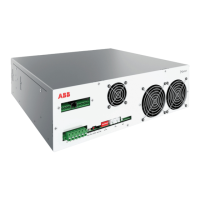
Do you have a question about the ABB PQstorI and is the answer not in the manual?
| Brand | ABB |
|---|---|
| Model | PQstorI |
| Category | Industrial Equipment |
| Language | English |
Covers critical safety precautions for installation, maintenance, and operation.
Details specific electrical hazards like capacitor discharge and grounding.
Explains precautions related to phase rotation and neutral current.
Emphasizes following battery manufacturer safety instructions for high voltage operation.
Details external connection terminals and signaling features.
Provides a block diagram of the main internal components.
Shows schematic overview of external connections to the product.
Explains the meaning of front panel LEDs indicating system status.
Describes the function of the front panel button for system control.
Guide to connecting to the product's Wi-Fi network for interface access.
Explains how to use the Wi-Fi interface, including status and navigation elements.
Details the function and meaning of the system status button on the interface.
Overview of electrical network properties and system settings.
Configuration of standby mode, clock, and power set points.
Configuration of network, AIP characteristics, CT settings, and derating.
Provides system status, load, event logging, and error checking.
Procedure for starting and stopping the PQstorl system.
How to track current and voltage on electrical network lines.
How to consult system errors and important events.
How to access manufacturer details of the product.
Recommended frequency for maintenance operations.
Procedure for checking system faults and operating hours.
Instructions for cleaning the module and tightening screws.
Details AC grid-tied and DC energy source connection specifications.
Covers ambient temperature, humidity, and pollution degree.
Outlines efficiency, accuracy, power factor, and overload capability.
Lists specifications for Wi-Fi, USB, RJ12, CT inputs, and relay output.
Details mounting, dimensions, color, fixation, and cable entry.
Lists safety, EMC, and certification standards.
Information required for identifying the product and its software versions.
Checklist for verifying installation and ambient conditions.
Steps for applying voltage and programming equipment settings.
Procedures for testing the system with battery charge/discharge cycles.
Lists programmed alarm, warning, and start-stop parameters.
Section for recording comments from commissioning engineers and representatives.